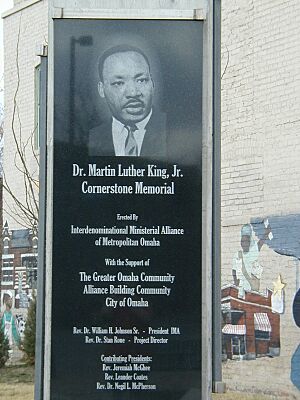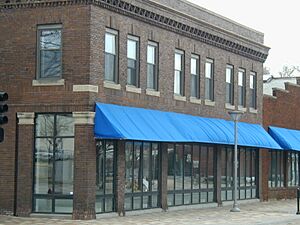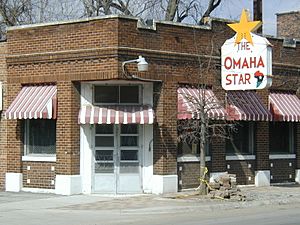North 24th Street facts for kids
| South end | Dodge Street 41°15′35″N 95°56′49″W / 41.25972°N 95.94694°W |
|---|---|
| North end | Read Street 41°19′24″N 95°56′49″W / 41.32333°N 95.94694°W |
North 24th Street is an important road in North Omaha, Omaha, Nebraska, USA. It runs from south to north. The most historically important part of the street stretches from Cuming Street to Ames Avenue.
Many people call a section of North 24th Street the "Main Street" of the Near North Side area. It was even known as "The Street of Dreams" in the past. This street is seen as the center of Omaha's African-American community.
Contents
History of North 24th Street

North 24th Street first became a busy place in the 1870s and 1880s. At that time, many Jewish families settled in Omaha. They opened shops along the street to help other new immigrants.
The street was full of businesses like bakeries, clothing stores, grocery shops, drug stores, and laundries. There were also many places of worship, such as synagogues and churches, along with funeral homes. In the 1910s, the father of famous author Tillie Olsen worked at a candy shop on North 24th Street.
A powerful tornado hit in 1913 on Easter Sunday. It caused a lot of damage and sadness along the North 24th Street area.
After a tragic event in 1919 where a person named Will Brown was killed, African-American residents in Omaha faced unfair housing rules. These rules, called redlining and race-restrictive covenants, made it hard for them to invest in their homes or move to other areas. Because of this, the Near North Side became a neighborhood mainly for African Americans.
North 24th Street became the heart of Omaha's most important African-American neighborhood. In the 1920s, many businesses and cultural spots owned by African Americans opened here. Places like the Dreamland Ballroom, where important "black movement" events happened, and several movie theaters and churches were built. The street continued to be a lively place into the 1950s. Many African Americans found better jobs and went to college during this time.
Challenges and Changes on the Street
On July 4, 1966, the first of several periods of civil unrest happened on North 24th Street. After a very hot day, a crowd gathered at North 24th and Lake Streets. This was the center of the Near North Side. When police asked them to leave, the crowd reacted strongly. They damaged police cars and nearby businesses.
The crowd moved along the North 24th Street business area for hours. They set fire to empty buildings and broke storefronts. This caused millions of dollars in damage. The unrest continued for three days. Within a month, more unrest happened. On August 1, it started again after a 19-year-old was shot by an off-duty white policeman during a burglary. Three buildings on North 24th Street were firebombed. More than 180 riot police were needed to calm the situation.
On June 24, 1969, a sad incident occurred where a teenager named Vivian Strong died after being shot by police officers near the Logan Fontenelle Housing Projects on North 24th Street. Young African Americans in the area protested. There was looting throughout the North 24th Street business area. Eight businesses were destroyed by fire or looting. These events continued for several days.
The business area along North 24th Street has faced challenges since these events. However, new money invested by the City of Omaha since 2000 has shown "promising returns," meaning things are starting to improve.
Neighborhoods Along North 24th Street
North 24th Street starts at Dodge Street in Downtown Omaha. As you go north, the street passes under I-480 and through the Creighton University campus in the NoDo area.
The Near North Side neighborhood begins after crossing Cuming Street. The intersection of North 24th and Lake Streets is considered the heart of North Omaha and the city's African American community.
North 24th Street continues to Binney Street, which is the start of the Kountze Place neighborhood. The intersection of North 24th and Ames was once an important shopping area. Another important spot was the intersection with Fort Street, about two miles north. The area between these two points is the historic Saratoga neighborhood.
After crossing the Storz Expressway, the street goes through the Miller Park neighborhood and then the Minne Lusa neighborhood. It finally ends at Read Street.
Revitalizing North 24th Street
In 2006, the Greater Omaha Chamber of Commerce started the North Omaha Development Project. This project aims to bring new businesses, culture, and social improvements to North Omaha. Planners want to create a strong local market and a good neighborhood for its residents and businesses. This effort is happening especially after the nearby NoDo area was redeveloped.
The plan includes expanding Creighton University. It also involves creating a "dual gateway" at 24th and Cuming. The south side of this intersection would be a nice entrance to Creighton. The north side would become a "retail village" leading into North Omaha.
Along North 24th to Parker Street, there could be new housing like townhouses. The area around North 24th and Lake Streets would focus on arts, entertainment, and culture. This plan uses places like Love's Jazz and Art Center and the Dreamland Plaza. A new theater and an African-American museum near the intersection could make it an even stronger cultural center for North Omaha.
The City of Omaha is also helping with the North 24th Street Historic Jazz District Project. This project focuses on the street between Ohio and Cuming Street. It is funded by nearly $2 million in city and federal money. The total cost is estimated to be between $3.5 million and $4.5 million.
Notable Places on North 24th Street
Many important Omaha Landmarks are located along North 24th Street. Here are some of them:
- The Calvin Memorial Presbyterian Church was built in 1910 at 3105 North 24th Street.
- The Jewell Building was built in 1923 at 2221 North 24th Street.
- The Redick Mansion, built in 1875, was the first home of Omaha University in 1909. It was located at 3612 North 24th Street.
- The Paul Street School was built at 1311 North 24th Street in 1892. It was replaced by Kellom Elementary School in 1952.
- The Omaha Star building at 2216 North 24th Street was once a funeral home and social hall. Now, it is home to the historic Omaha Star newspaper.
- The notable Druid Hall is located at 2412 Ames Avenue, just off North 24th Street.
- Further north is Pearl Memorial United Methodist Church, located at North 24th and Ogden Avenue. Even further north is Miller Park.
Other important places include:
- The Fair Deal Cafe was once known as Omaha's "Black City Hall." It is now being restored.
- Carver Savings and Loan Association was the city's first African American banking institution. It is also being revitalized. Both of these are on North 24th Street.
- Love’s Jazz and Art Center is named after Preston Love, who grew up in North Omaha. It is located at 2510 North 24th Street.
- The Native Omaha Club is at 3819 North 24th Street.
- The Dr. Martin Luther King Jr. Cornerstone Memorial was put in place in 2006. It is at the intersection of North 24th and Lake Streets.
- The Dreamland Plaza was created in 2004. It honors the Dreamland Ballroom and is located at North 24th and Erskine Streets.
- The Native Omaha Days parade happens every two years along North 24th Street. It has been held since the mid-1970s.





